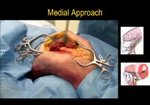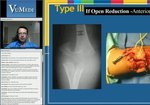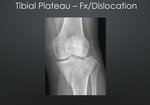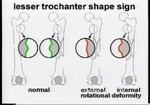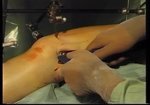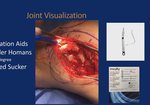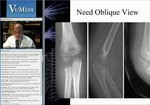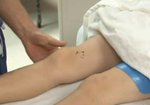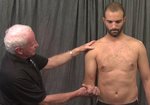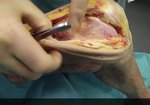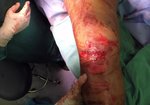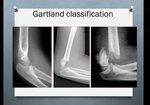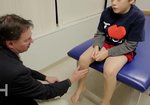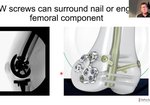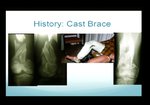
Video Player is loading.
Current Time 0:00
/
Duration 0:00
Loaded: 0%
Stream Type LIVE
1x
- 0.5x
- 0.75x
- 1x, selected
- 1.25x
- 1.5x
- 1.75x
- 2x
- Chapters
- descriptions off, selected
- captions settings, opens captions settings dialog
- captions off, selected
This is a modal window.
Beginning of dialog window. Escape will cancel and close the window.
End of dialog window.
10 seconds
Playback speed
This is a modal window. This modal can be closed by pressing the Escape key or activating the close button.
Controversies and Current Evidence in Pediatric Sports Medicine
2,470 views
May 27, 2020
Controversies and Current Evidence in Pediatric Sports Medicine
FRACTURES
ACSM Denver, CO May 31, 2017 ...
read more ↘
Mary Lloyd Ireland, M.D. Professor
University of Kentucky
Dept. of Orthopaedic Surgery and Sports Medicine Lexington, Kentucky
www.marylloydireland.com
I have nothing to disclose
Menu
Introduction Throwing Knee / Fractures Hip
Ankle / Foot Conclusions
Open or not?? Neurologically intact?? Description of Location and Patterns Mode of injury Fractures
Fracture angulation Fracture displacement Articular involvement
Fracture Healing
Three stages
More neurologic recovery
More surface area/volume = more temp loss Less significant hemorrhage
Fewer pulmonary complications
Large head forces C-spine into flexion
Not “Small Adults”
Unique Properties of Growing Skeleton
Open growth plates
Greater potential for remodeling
Bone w/ more resiliency to stress
Remodeling
Amount of growth • Patient age
Bone / physis involved
Location in bone – ie: proximity to physis
Deformity in plane of motion
Physeal Fractures
20 % of all children
1% will develop growth arrests fractures
Complete - shortening
• Partial
• Shortening
• Angular deformity
Complete
• Observation
• Contralateral epiphysiodesis
• Lengthening
Physeal Arrest
Distal Radius
frequently a buckle fracture Delayed presentation common
Sprain - Beware of imitators
Unique Properties of Growing Skeleton
Periosteum thicker
Cartilage thicker / more vascular
Greenstick more likely to refracture (5%)
Displaced fractures
• Splint them as they lie
• Apply axial traction as assistant applies splint
Both Bone Forearm Fractures
Limits of acceptable reduction ? Functional complaints rare
Remember to remove rings immediately!
Types of Injuries
Microtraumatic vs. Macrotraumatic
Repetitive Major Accident
Skeletally Immature Uniqueness of Injuries
• Open Growth Plates
• Immature Skeleton
• Physiologically Lax Joints • Psychological
• Want to Please
• Feel no Pain
The Problem
• 30 million children participate in organized sports
(Source: Safe Kids USA)
• Participation in high school athletics is increasing, with
more than 7.3 million high school students participating
annually
(Source: National Federation of State High School Associations)
• High school athletics account for more than 2 million injuries annually, including
500,000 doctor visits
30,000 hospitalizations
(Source: Centers for Disease Control)
The Problem
• Young athletes are specializing in sports (and
positions) at an earlier age, with more than 3.5 million
children under the age of 14 treated annually for sports
injuries.
(Source: Safe Kids USA)
• Immature bones, insufficient rest after injury, poor training and conditioning contribute to overuse injuries.
• Overuse injuries account for half of all sports injuries
in middle school and high school.
(Source: Safe Kids USA)
Survey 7-13 Years Old Children
Two playing seasons
Community organized
Injury rates per 1000 athlete-exposures: Soccer 2.1
Baseball 1.7 Football 1.5 Softball 1.0
Radelet MA, Lephart SM, Rubinstein EN, Myers JB, “Survey of the injury rate for children in community sports,” Pediatrics 2002;110:E28.
A Free Play B Organized Sports C Neither Children should Not play Sports D Neither Based on Current Research
Introduction
3.5 million children < age 12 treated for sports injuries
50% of injuries are overuse
Epidemic injury patterns in youth sports – elbow injuries in pitchers
Children participating in sports each year:
30 million
Enemy: Valgus & Rotation
UCL ACL PF
Little League pitchers do NOT become Big League pitchers
Physeal and ROM Changes
Increased physeal width on dominant side Increased ER dominant side
Mair SD, Uhl TL, Robbe RG, Brindle KA, “Physeal changes and range-of-motion differences in the dominant shoulders of skeletally immature baseball players,” J Shoulder Elbow Surg 2004 Sep-Oct;13(5):487-91.
79 youth baseball players
• Age8–15years
Little Leaguer’s Shoulder
Youth Elbow: Baseball Pitcher
Little Leaguer’s Elbow Described by Adams, 1964
1980s: osteochondritis dissecans
• Incidence reduced in US? from pitch count restrictions?
• Increased incidence in Japan
Medial humeral epicondyle stress fracture
• My definition of Little Leaguer’s Elbow
Need Injury Registry
for childhood sports injuries
2000: ulnar collateral ligament tears Epidemic
Appearance and fusion of secondary ossification centers of the elbow in females and males
from Andrews JA, et. al., Injuries in Baseball, Lippincott-Raven, 1998.
Lateral Forces = Compression Medial Forces = Tension
© 2007 Kentucky Sports Medicine
Medial elbow pain diagnoses in throwers
Medial epicondyle stress fracture
UCL tear
Ulnar neuritis/hypermobility Flexor-pronator strain much less common Subluxating medial triceps
Valgus extension overload • (elbow impingement)
Sublime tubercle fracture proximal ulna
13 YO Male
Medial Right elbow pain
Football quarterback and baseball pitcher
Referred in with diagnosis of “Little Leaguer’s elbow”
Initial view: Right elbow
Pain when throwing football or baseball for 2 months
12 YO boy
Felt pop in medial elbow
Did not seek medical attention Sat out rest of season, got better Played football -- no problems
Rapid growth phase, medial elbow pain when started pitching again
Case courtesy of Dr. Adam Smith
Little Leaguer injured while pitching 5 months prior
Elbow initial x-rays
Medial epicondyle displaced fracture UCL tear complete vs. partial
Follow up:
2 weeks: 6-weeks: 7 months:
4-weeks: 4 months:
19 months:
19-month follow up
8th Grade
• 14y,6mos
6'3
• 217 lbs.
14 YO Pitcher, medial elbow pain for a year, open medial humeral epiphysis torn UCL
Stress Views
UCL reconstruction performed, baseball career ended
BB Bullet Appearance to medial epicondyle fracture
May heal if you don’t allow pitching too early
May take long time to heal, but UCL is intact
BB Gun
Don’t allow to fire too soon
Risk Factors
95 pitchers surgery / 45 adolescent no surgery Multivariant Analysis, Injury Risk Pitching:
• >8 months/year 5-fold • >80 pitches/game 4-fold • >85mph 2.6X
Dr. Andrews:
“. . . the speed gun is the worst invention in the history of Little League baseball.”
Overuse Fatigue High Pitch Velocity
• Showcase Participation
• Age Groups – Age Matched Case Control Study
Arm fatigue 36X
Olsen II SJ, Fleisig GS, Dun S, Loftice J, Andrews JR, “Risk Factors for Shoulder and Elbow Injuries in Adolescent Baseball Pitchers,” Am J Sports Med 34(6); 2006,905-912.
Conclusion:
13 YO “Big Pitcher” Syndrome
Skeletally and mentally immature
Fast growth phase
Poor pitching Hip weakness mechanics
= UE overuse injury
Protect our young athletes
• Reduce rate of Rotator Cuff and UCL tears in young pitchers
14 YO WM
RHD baseball player, wrestler, and football player Right elbow pain posterior over the olecranon
6 months following initial symptoms, recurrent posterior elbow pain
3 months post op
14 YO Football Athlete
Back of arm hit during practice Elbow posterior dislocation
Epiphyseal Fracture Rates - Lower Extremity
Ogden
Distal femur Proximal tibia Distal tibia Distal fibula
Proximal femur
Cited In Ogden JA, Skeletal Injury in the Child (Philadelphia: W.B. Saunders, 1990).
% of each bone
% of entire extremity
Contribution of
Growth Plate to Length
LOWER EXTREMITY
Femoral growth 9 mm./ year Tibial growth 6 mm. / year
Neer CS II, Horwitz BS, Fractures of the epiphyseal plate.
Clin Orthop 41:24, 1965.
Peterson CA, Peterson HA, Analysis of the incidence of injuries to the epiphyseal growth plate.
J. Trauma 12:275, 1972.
Cited In Ogden JA, Skeletal Injury in the Child (Philadelphia: W.B. Saunders, 1990).
Appearance and Closure of Secondary Ossification Centers
LOWER EXTREMITY
Salter-Harris Fractures
Kay RM and Matthys GA, "Pediatric Ankle Fractures: Evaluation and Treatment," JAAOS 9:4 (July-August 2001); 268-278.
14 YO WM Punter Was Hit
14 YO punter was crushed by defensive line
“Fractures of the distal femoral epiphyseal plate.
–Thomson JD et al. J Pediatr Orthop 1995; 15(4):474-478.
18 (60%) Excellent 8 (27%) Fair
4 (13%) Poor
All 29 Patients:
Poor Outcome if Displaced >50%
14 Year + 4 Mo. Old Male
Koman JD and Sanders JO, “Valgus Deformity After Reconstruction of the Anterior Cruciate Ligament in a Skeletally Immature Patient,” JBJS Vol. 81A, No.5 (May 1999), pp. 711-715.
16 YO WM Football Athlete Struck from Lateral Side of Knee 15 year old walked funny since a bicycle crash 4 years ago
MRI scan at time of initial injury
JamesAaronMatthews.mpg
16 YO BM Basketball Athlete
L proximal tibia Salter IV Fracture Ogden IIIB
Proximal Tibial Fractures
Displaced
• Neuro-vascular compromise
• Compartment syndrome Medial Buckle
• Progressive valgus-s fracture
• Observe Cozen
13 year old Soccer Athlete Kicked a Ball Planted
Felt a Pop
LLE Displaced, Comminuted Tibial Tubercle Fracture
13 YO Male
• Fell Off of His Bicycle • C/O Swelling + Pain
Left Knee
TIBIAL EMINENCE FRACTURES
Meyers and McKeever Classification of tibial eminence fractures.
ACL Tibial Eminence
LM
ACL
Screw
You May Not Have Seen It, But It Has Seen You
Pathologic Fractures UBC
• Only 10 % heal w/ fracture • Steroid / Grafton > ICBG
ABC
NOF
Fibrous dysplasia
Shepherds Crook
16 YO Hit Playing Basketball a month ago. No prior knee problems.
Right Distal Femur Osteosarcoma
13 YO WM
C/O Knee Pain x 18 months Pain on ROM
Hip Radiating to Knee
SCFE
Moves Posterior First Check Lateral View
Keats TE, Radiology of Musculoskeletal Stress Injury (Chicago: Year Book Medical Publishers, 1990),
External Oblique
Sartorius
Rectus
Iliopsoas Hamstrings
AIIS Avulsion Fracture – Rectus Femoris
15 YO ASIS Avulsion Fracture - Sartorius
2 months
13 YO Baseball player
Stretching in gym
Felt right groin pain after running to first
Initial Xrays Right
Left
Ischial Tuberosity Apophyseal Avulsion - Hamstring
14 YO Soccer Athlete
Lesser Trochanter Avulsion Fracture Iliopsoas Snapping Hip Syndrome
External:
Iliotibial band on greater trochanter
Most common
Internal – coxa soltans
Iliopsoas tendon on anterior capsule
Ballet dancer
14 YO Male
Left ankle
Tillaux fracture with displacement
CT Scan
Sever’s Disease
Heel pain growth spurt
Journal of Pediatric Orthopedics 7:34 - 38 © 1987 Raven Press, New York Prevention and Management of Calcaneal Apophysitis Children: An Overuse Syndrome . Ill Lyle J. Micheli, M.D., and M. Lloyd Ireland, M.D. Division of Sports Medicine, Children's Hospital Medical Center, Boston, Massachusetts
More common Boys Soccer Peak Age 11
Journal of Pediatric Orthopedics 7:34 - 38 © 1987 Raven Press, New York Prevention and Management of Calcaneal Apophysitis Children: An Overuse Syndrome . Ill Lyle J. Micheli, M.D., and M. Lloyd Ireland, M.D. Division of Sports Medicine, Children's Hospital Medical Center, Boston, Massachusetts
Catastrophic Cheerleading Injuries
NCCSIR 2 Direct Catastrophic Injuries/Year
(0.6 per 100.000 cheerleaders)
CPSC estimated 1258 head injuries
1814 neck injuries in cheerleaders of all ages
6 skull fxs
76 cervical fractures
Barry P. Boden: Direct Catastrophic Injury in Sports. JAAOS 13(7):445–454, Nov 2005
Cheerleading is associated with the highest # of Direct Catastrophic Injuries for all sports in which females participate
National Center for Catastrophic Sports Injury Research: Twentieth Annual Report, Fall 1982 Spring 2002. Chapel Hill, NC: National Center for Sports Injury Research, 2002, pp1-25
Prevention Strategies Coaches Should:
Supervise all practices Be safety certified
Have an emergency plan
Cheerleaders Should:
Have a preparticipation physical exam
Be trained in gymnastics, spotting, conditioning Participate in stunts they have mastered
From Cantu RC, Mueller FO, “Fatalities and Catastrophic Injuries in High School and College Sports, 1982-1997,” The Physician and Sportsmedicine 27(8); 35-48.
STOP Elbow Injuries in Youth Baseball: Youth Sports Injury Prevention
ports rauma and
veruse revention
www.stopsportsinjuries.org/
T O
Should the “STOP” program really be the “GO and PARTICIPATE in activities” program?
We all should encourage our youth to be physically active, fit, and healthy . . .
Which is Safer?
Organized Sports or Free Play?
A. Free Play
B. Organized Sports
C. Neither Children should Not play Sports
D. Neither Based on Current Research
My answer:
Need youth injury registries Moderation
Let them have fun
Can you identify the adult?
Unique Aspects
Young athletes: Feel no pain
Goal is to please parents, peers, coaches Must be protected
I Am Invincible!
Conclusions
They heal and act differently.
Encourage Participation in sports
Children are not little adults.
Protect our young
Athletes
Learn how to land at a good age
Encourage physical activity
Make sports fun and exciting
Sports allowed me to succeed in a male- dominated career and stay active
MLI, on swing set, real band-aids
Mary Lloyd Ireland, M.D.
Professor
University of Kentucky
Dept. of Orthopaedic Surgery and Sports Medicine Lexington, Kentucky
www.marylloydireland.com
↖ read less
ACSM Denver, CO May 31, 2017 ...
read more ↘
Mary Lloyd Ireland, M.D. Professor
University of Kentucky
Dept. of Orthopaedic Surgery and Sports Medicine Lexington, Kentucky
www.marylloydireland.com
I have nothing to disclose
Menu
Introduction Throwing Knee / Fractures Hip
Ankle / Foot Conclusions
Open or not?? Neurologically intact?? Description of Location and Patterns Mode of injury Fractures
Fracture angulation Fracture displacement Articular involvement
Fracture Healing
Three stages
More neurologic recovery
More surface area/volume = more temp loss Less significant hemorrhage
Fewer pulmonary complications
Large head forces C-spine into flexion
Not “Small Adults”
Unique Properties of Growing Skeleton
Open growth plates
Greater potential for remodeling
Bone w/ more resiliency to stress
Remodeling
Amount of growth • Patient age
Bone / physis involved
Location in bone – ie: proximity to physis
Deformity in plane of motion
Physeal Fractures
20 % of all children
1% will develop growth arrests fractures
Complete - shortening
• Partial
• Shortening
• Angular deformity
Complete
• Observation
• Contralateral epiphysiodesis
• Lengthening
Physeal Arrest
Distal Radius
frequently a buckle fracture Delayed presentation common
Sprain - Beware of imitators
Unique Properties of Growing Skeleton
Periosteum thicker
Cartilage thicker / more vascular
Greenstick more likely to refracture (5%)
Displaced fractures
• Splint them as they lie
• Apply axial traction as assistant applies splint
Both Bone Forearm Fractures
Limits of acceptable reduction ? Functional complaints rare
Remember to remove rings immediately!
Types of Injuries
Microtraumatic vs. Macrotraumatic
Repetitive Major Accident
Skeletally Immature Uniqueness of Injuries
• Open Growth Plates
• Immature Skeleton
• Physiologically Lax Joints • Psychological
• Want to Please
• Feel no Pain
The Problem
• 30 million children participate in organized sports
(Source: Safe Kids USA)
• Participation in high school athletics is increasing, with
more than 7.3 million high school students participating
annually
(Source: National Federation of State High School Associations)
• High school athletics account for more than 2 million injuries annually, including
500,000 doctor visits
30,000 hospitalizations
(Source: Centers for Disease Control)
The Problem
• Young athletes are specializing in sports (and
positions) at an earlier age, with more than 3.5 million
children under the age of 14 treated annually for sports
injuries.
(Source: Safe Kids USA)
• Immature bones, insufficient rest after injury, poor training and conditioning contribute to overuse injuries.
• Overuse injuries account for half of all sports injuries
in middle school and high school.
(Source: Safe Kids USA)
Survey 7-13 Years Old Children
Two playing seasons
Community organized
Injury rates per 1000 athlete-exposures: Soccer 2.1
Baseball 1.7 Football 1.5 Softball 1.0
Radelet MA, Lephart SM, Rubinstein EN, Myers JB, “Survey of the injury rate for children in community sports,” Pediatrics 2002;110:E28.
A Free Play B Organized Sports C Neither Children should Not play Sports D Neither Based on Current Research
Introduction
3.5 million children < age 12 treated for sports injuries
50% of injuries are overuse
Epidemic injury patterns in youth sports – elbow injuries in pitchers
Children participating in sports each year:
30 million
Enemy: Valgus & Rotation
UCL ACL PF
Little League pitchers do NOT become Big League pitchers
Physeal and ROM Changes
Increased physeal width on dominant side Increased ER dominant side
Mair SD, Uhl TL, Robbe RG, Brindle KA, “Physeal changes and range-of-motion differences in the dominant shoulders of skeletally immature baseball players,” J Shoulder Elbow Surg 2004 Sep-Oct;13(5):487-91.
79 youth baseball players
• Age8–15years
Little Leaguer’s Shoulder
Youth Elbow: Baseball Pitcher
Little Leaguer’s Elbow Described by Adams, 1964
1980s: osteochondritis dissecans
• Incidence reduced in US? from pitch count restrictions?
• Increased incidence in Japan
Medial humeral epicondyle stress fracture
• My definition of Little Leaguer’s Elbow
Need Injury Registry
for childhood sports injuries
2000: ulnar collateral ligament tears Epidemic
Appearance and fusion of secondary ossification centers of the elbow in females and males
from Andrews JA, et. al., Injuries in Baseball, Lippincott-Raven, 1998.
Lateral Forces = Compression Medial Forces = Tension
© 2007 Kentucky Sports Medicine
Medial elbow pain diagnoses in throwers
Medial epicondyle stress fracture
UCL tear
Ulnar neuritis/hypermobility Flexor-pronator strain much less common Subluxating medial triceps
Valgus extension overload • (elbow impingement)
Sublime tubercle fracture proximal ulna
13 YO Male
Medial Right elbow pain
Football quarterback and baseball pitcher
Referred in with diagnosis of “Little Leaguer’s elbow”
Initial view: Right elbow
Pain when throwing football or baseball for 2 months
12 YO boy
Felt pop in medial elbow
Did not seek medical attention Sat out rest of season, got better Played football -- no problems
Rapid growth phase, medial elbow pain when started pitching again
Case courtesy of Dr. Adam Smith
Little Leaguer injured while pitching 5 months prior
Elbow initial x-rays
Medial epicondyle displaced fracture UCL tear complete vs. partial
Follow up:
2 weeks: 6-weeks: 7 months:
4-weeks: 4 months:
19 months:
19-month follow up
8th Grade
• 14y,6mos
6'3
• 217 lbs.
14 YO Pitcher, medial elbow pain for a year, open medial humeral epiphysis torn UCL
Stress Views
UCL reconstruction performed, baseball career ended
BB Bullet Appearance to medial epicondyle fracture
May heal if you don’t allow pitching too early
May take long time to heal, but UCL is intact
BB Gun
Don’t allow to fire too soon
Risk Factors
95 pitchers surgery / 45 adolescent no surgery Multivariant Analysis, Injury Risk Pitching:
• >8 months/year 5-fold • >80 pitches/game 4-fold • >85mph 2.6X
Dr. Andrews:
“. . . the speed gun is the worst invention in the history of Little League baseball.”
Overuse Fatigue High Pitch Velocity
• Showcase Participation
• Age Groups – Age Matched Case Control Study
Arm fatigue 36X
Olsen II SJ, Fleisig GS, Dun S, Loftice J, Andrews JR, “Risk Factors for Shoulder and Elbow Injuries in Adolescent Baseball Pitchers,” Am J Sports Med 34(6); 2006,905-912.
Conclusion:
13 YO “Big Pitcher” Syndrome
Skeletally and mentally immature
Fast growth phase
Poor pitching Hip weakness mechanics
= UE overuse injury
Protect our young athletes
• Reduce rate of Rotator Cuff and UCL tears in young pitchers
14 YO WM
RHD baseball player, wrestler, and football player Right elbow pain posterior over the olecranon
6 months following initial symptoms, recurrent posterior elbow pain
3 months post op
14 YO Football Athlete
Back of arm hit during practice Elbow posterior dislocation
Epiphyseal Fracture Rates - Lower Extremity
Ogden
Distal femur Proximal tibia Distal tibia Distal fibula
Proximal femur
Cited In Ogden JA, Skeletal Injury in the Child (Philadelphia: W.B. Saunders, 1990).
% of each bone
% of entire extremity
Contribution of
Growth Plate to Length
LOWER EXTREMITY
Femoral growth 9 mm./ year Tibial growth 6 mm. / year
Neer CS II, Horwitz BS, Fractures of the epiphyseal plate.
Clin Orthop 41:24, 1965.
Peterson CA, Peterson HA, Analysis of the incidence of injuries to the epiphyseal growth plate.
J. Trauma 12:275, 1972.
Cited In Ogden JA, Skeletal Injury in the Child (Philadelphia: W.B. Saunders, 1990).
Appearance and Closure of Secondary Ossification Centers
LOWER EXTREMITY
Salter-Harris Fractures
Kay RM and Matthys GA, "Pediatric Ankle Fractures: Evaluation and Treatment," JAAOS 9:4 (July-August 2001); 268-278.
14 YO WM Punter Was Hit
14 YO punter was crushed by defensive line
“Fractures of the distal femoral epiphyseal plate.
–Thomson JD et al. J Pediatr Orthop 1995; 15(4):474-478.
18 (60%) Excellent 8 (27%) Fair
4 (13%) Poor
All 29 Patients:
Poor Outcome if Displaced >50%
14 Year + 4 Mo. Old Male
Koman JD and Sanders JO, “Valgus Deformity After Reconstruction of the Anterior Cruciate Ligament in a Skeletally Immature Patient,” JBJS Vol. 81A, No.5 (May 1999), pp. 711-715.
16 YO WM Football Athlete Struck from Lateral Side of Knee 15 year old walked funny since a bicycle crash 4 years ago
MRI scan at time of initial injury
JamesAaronMatthews.mpg
16 YO BM Basketball Athlete
L proximal tibia Salter IV Fracture Ogden IIIB
Proximal Tibial Fractures
Displaced
• Neuro-vascular compromise
• Compartment syndrome Medial Buckle
• Progressive valgus-s fracture
• Observe Cozen
13 year old Soccer Athlete Kicked a Ball Planted
Felt a Pop
LLE Displaced, Comminuted Tibial Tubercle Fracture
13 YO Male
• Fell Off of His Bicycle • C/O Swelling + Pain
Left Knee
TIBIAL EMINENCE FRACTURES
Meyers and McKeever Classification of tibial eminence fractures.
ACL Tibial Eminence
LM
ACL
Screw
You May Not Have Seen It, But It Has Seen You
Pathologic Fractures UBC
• Only 10 % heal w/ fracture • Steroid / Grafton > ICBG
ABC
NOF
Fibrous dysplasia
Shepherds Crook
16 YO Hit Playing Basketball a month ago. No prior knee problems.
Right Distal Femur Osteosarcoma
13 YO WM
C/O Knee Pain x 18 months Pain on ROM
Hip Radiating to Knee
SCFE
Moves Posterior First Check Lateral View
Keats TE, Radiology of Musculoskeletal Stress Injury (Chicago: Year Book Medical Publishers, 1990),
External Oblique
Sartorius
Rectus
Iliopsoas Hamstrings
AIIS Avulsion Fracture – Rectus Femoris
15 YO ASIS Avulsion Fracture - Sartorius
2 months
13 YO Baseball player
Stretching in gym
Felt right groin pain after running to first
Initial Xrays Right
Left
Ischial Tuberosity Apophyseal Avulsion - Hamstring
14 YO Soccer Athlete
Lesser Trochanter Avulsion Fracture Iliopsoas Snapping Hip Syndrome
External:
Iliotibial band on greater trochanter
Most common
Internal – coxa soltans
Iliopsoas tendon on anterior capsule
Ballet dancer
14 YO Male
Left ankle
Tillaux fracture with displacement
CT Scan
Sever’s Disease
Heel pain growth spurt
Journal of Pediatric Orthopedics 7:34 - 38 © 1987 Raven Press, New York Prevention and Management of Calcaneal Apophysitis Children: An Overuse Syndrome . Ill Lyle J. Micheli, M.D., and M. Lloyd Ireland, M.D. Division of Sports Medicine, Children's Hospital Medical Center, Boston, Massachusetts
More common Boys Soccer Peak Age 11
Journal of Pediatric Orthopedics 7:34 - 38 © 1987 Raven Press, New York Prevention and Management of Calcaneal Apophysitis Children: An Overuse Syndrome . Ill Lyle J. Micheli, M.D., and M. Lloyd Ireland, M.D. Division of Sports Medicine, Children's Hospital Medical Center, Boston, Massachusetts
Catastrophic Cheerleading Injuries
NCCSIR 2 Direct Catastrophic Injuries/Year
(0.6 per 100.000 cheerleaders)
CPSC estimated 1258 head injuries
1814 neck injuries in cheerleaders of all ages
6 skull fxs
76 cervical fractures
Barry P. Boden: Direct Catastrophic Injury in Sports. JAAOS 13(7):445–454, Nov 2005
Cheerleading is associated with the highest # of Direct Catastrophic Injuries for all sports in which females participate
National Center for Catastrophic Sports Injury Research: Twentieth Annual Report, Fall 1982 Spring 2002. Chapel Hill, NC: National Center for Sports Injury Research, 2002, pp1-25
Prevention Strategies Coaches Should:
Supervise all practices Be safety certified
Have an emergency plan
Cheerleaders Should:
Have a preparticipation physical exam
Be trained in gymnastics, spotting, conditioning Participate in stunts they have mastered
From Cantu RC, Mueller FO, “Fatalities and Catastrophic Injuries in High School and College Sports, 1982-1997,” The Physician and Sportsmedicine 27(8); 35-48.
STOP Elbow Injuries in Youth Baseball: Youth Sports Injury Prevention
ports rauma and
veruse revention
www.stopsportsinjuries.org/
T O
Should the “STOP” program really be the “GO and PARTICIPATE in activities” program?
We all should encourage our youth to be physically active, fit, and healthy . . .
Which is Safer?
Organized Sports or Free Play?
A. Free Play
B. Organized Sports
C. Neither Children should Not play Sports
D. Neither Based on Current Research
My answer:
Need youth injury registries Moderation
Let them have fun
Can you identify the adult?
Unique Aspects
Young athletes: Feel no pain
Goal is to please parents, peers, coaches Must be protected
I Am Invincible!
Conclusions
They heal and act differently.
Encourage Participation in sports
Children are not little adults.
Protect our young
Athletes
Learn how to land at a good age
Encourage physical activity
Make sports fun and exciting
Sports allowed me to succeed in a male- dominated career and stay active
MLI, on swing set, real band-aids
Mary Lloyd Ireland, M.D.
Professor
University of Kentucky
Dept. of Orthopaedic Surgery and Sports Medicine Lexington, Kentucky
www.marylloydireland.com
↖ read less
Comments 0
Login to view comments.
Click here to Login




